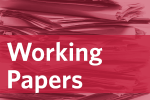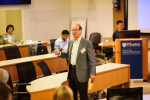
When digital turbulence is the new normal, vigilant organizations prevail by following three navigation principles. …Read More

When digital turbulence is the new normal, vigilant organizations prevail by following three navigation principles. …Read More

Seven pitfalls that companies need to steer clear of to effectively leverage this novel technology, and a framework to help gauge readiness for adoption.…Read More

Why are vigilant organizations better at developing foresight than their rivals and acting faster on the insights and alerts? Four attributes were hypothesized to explain the difference between vigilant and vulnerable organizations.…Read More

Beth Comstock, former CMO and Vice Chair at GE and author of Imagine It Forward, discusses how large firms can make themselves more adaptable and learn to spot the patterns that signal opportunities for innovation.…Read More

This proposal explores how information technology and innovation in digitization affect organizational structure. Similar to earlier wave of IT adoption that substituted certain routine tasks, we plan to use the Workplace and Employee Survey from Canada to show that this new wave digitization and IT investments can induce a structural change in organizational hierarchies that differ from prior technologies. …Read More

Nana Murugesan (WG’09), VP at Samsung Electronics, discusses how he can tell when it’s time to take an innovative leap.…Read More

Knowing both how and when to embrace disruption is key to your organization’s long-term success. Wharton’s Rahul Kapoor offers key steps managers can take.…Read More

This article examines the importance of plasticity and diversity in organizational adaptation and with respect to dynamic capabilities. It begins by conceptualizing what elements comprise a dynamic capability within an evolving organization using the contrast between templates (genotypes) and realized practices (phenotypes).…Read More

When considering the adaptive dynamics of organizations, it is important to account for the full set of adaptive mechanisms, including not only the possibility of learning and adaptation of a given behavior but also the internal selection over some population of routines and behaviors. In developing such a conceptual framework, it is necessary to distinguish between the underlying stable roots of behavior and the possibly adaptive expression of those underlying templates.…Read More

While much is understood about the general pattern of industry dynamics, a critical element underlying these dynamics, the rate of the expansion of individual firms, has been largely overlooked. We argue that the rate at which firms can reliably increase their scale of operations is a critical factor in understanding the structure of industries.…Read More

We assemble a panel data set of firms in the U.S. defense industry between 1996 and 2006 to examine the drivers of heterogeneous incumbent firm adaptation following the industry-wide demand shock of September 11, 2001.…Read More

With outsourcing growing and core capabilities contracting, is hierarchy becoming a thing of the past? Faculty from the Mack Institute talk corporate hierarchies today versus in the past.…Read More

One factor affecting the replicability of routines is the template of what gets replicated. There isn’t much work on where this comes from. One view is that the routine is discovered over time. Another view is that in some cases firms prefer to copy the last incarnation exactly.…Read More

Although the stylized model of industry evolution suggests that firms transform from vertical integration to specialization over time, many industries still exhibit a continued persistence of integrated firms. In exploring this puzzle, I draw on detailed firm-level data from the semiconductor industry to analyze how integrated incumbents, beyond shifting to the specialized mode, reconfigured in the face of industry’s vertical disintegration.…Read More

This paper aims to further the alignment among different theoretical approaches and future scholarship on the complex themes related to the micro-foundational processes characterizing the emergence and development of organizational routines and capabilities. It has been constructed with a typical Hegelian structure represented by a thesis, an antithesis and an attempt of a synthesis, each presented by different scholars.…Read More

The recognition that better use of existing knowledge can enhance performance has spawned substantial interest in the replication of productive knowledge within organizations. An enduring belief is that when expanding by replication, organizations can and should strive to adapt to fit the salient characteristics of new environments.…Read More